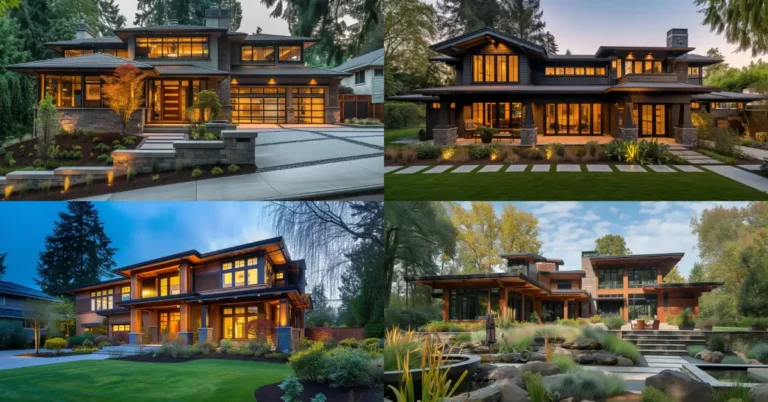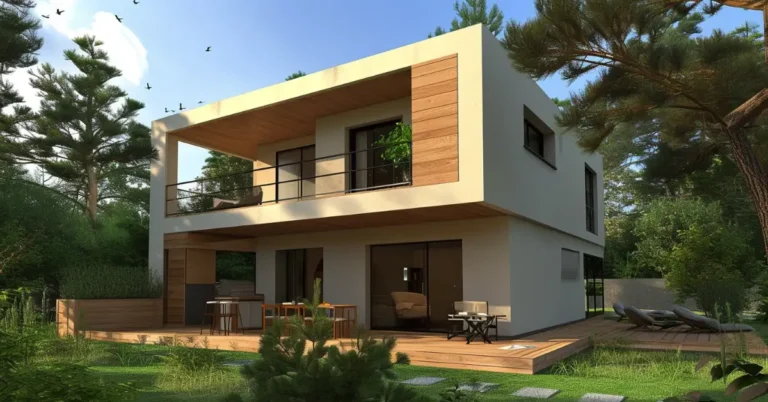Dive into the world of contemporary house exterior colors to immediately elevate your home’s modern aesthetic. Selecting the perfect color scheme is crucial for marrying functionality with personal style, ensuring your home stands out with a timeless yet bold statement. Embrace everything from muted, sleek palettes that harmonize with nature to dynamic, eye-catching hues that reflect your individuality.
Defining Contemporary Color Palettes
Talking about contemporary house exterior colors, we’re centering on a color palette that embodies modern sophistication while offering a welcoming appeal.
Establishing a Modern Aesthetic
To establish a modern aesthetic, we focus on clean lines, simplicity, and harmony between the architecture and its natural surroundings. We often see a prevalence of neutral colors because they provide a timeless elegance that complements various architectural features without overwhelming them. Cool grays and beiges are particularly popular, as they offer a subtle backdrop for bolder accents like doors or shutters.
Selecting a Main Exterior Paint Color
Choosing the main exterior paint color for a contemporary home is a thoughtful process. The color should reflect the personality of the home while still falling within the modern framework.
- Warm hues: These can range from a rich tan to a muted beige, providing a cozy and inviting atmosphere.
- Cool grays: A favorite for a sleek appearance, varying from light silvery tones to deep charcoal.
- Classic white: Always in vogue for its clean and crisp presence, it works well on its own or as trim.
- Bold gray: Acts as a strong foundation, allowing for creative expression through contrasting textures or colors.
These contemporary colors serve as an excellent starting point in defining the character and curb appeal of a modern-styled home.

Accentuating Features with Trim and Front Door Colors
We all know that the right accent can bring contemporary house exterior colors to life. Choosing the right trim and front door colors is essential to highlight your home’s features and show off your style.
Choosing Trim Color
When selecting trim color, it’s all about balance. White trim is a classic choice that creates a crisp contrast, especially against darker contemporary hues. This color not only frames your home beautifully but also complements a wide range of siding colors. On the other hand, trim in black can offer a bold and modern edge, making your windows and architectural details pop. It works exceptionally well with both neutral and vibrant exteriors, offering a sleek, finishing touch.
Front Door as a Focal Point
Your front door is more than just an entryway—it’s a statement piece. A bold color here can turn a door into a focal point and warmly welcome visitors. For example, painting your front door in a shade like deep red can add a sense of warmth and personality, which is particularly striking against a more subdued siding color. If you prefer something timeless, a black front door is a versatile option that speaks elegance and pairs seamlessly with diverse contemporary house exterior colors.

Contrast and Harmony in Color Choices
When we talk about contemporary house exterior colors, we’re looking at how bold hues play against neutrals to create visually compelling homes.
Balancing Neutrals and Bold Hues
Neutrals are the backbone of exterior color schemes, providing a canvas for bolder, more vibrant colors to stand out. Navy blue and deep green are examples of rich hues that can serve as a sophisticated base or an accent. When paired with soft grays or beiges, these colors contribute to a balanced and harmonious look, ensuring the house feels grounded yet modern.
The Role of Contrast in Modern Exteriors
Contrast is key in creating dynamic and appealing exteriors. Think of a deep green door against a light gray façade; this use of contrast draws the eye and gives a sense of depth and character. Red elements, whether they’re shutters or trim, can add that extra layer of dimension that makes a color scheme pop. Achieving the right contrast is about finding the sweet spot – too much can be jarring, while too little may seem flat.

Materials and Textures Impact on Color Selection
Selecting contemporary house exterior colors involves more than just picking a shade you love; it requires considering the materials and textures of your home. The right color can accentuate these elements, enhancing curb appeal and character.
Influence of Brick, Wood, and Stone
Brick: It’s a classic choice that offers warmth and durability. The inherent hues of brick—from deep reds to earthen browns—dictate a complementary color palette. For instance, if we have a reddish-brick exterior, we might opt for cool-toned colors to balance the warmth.
Wood: Natural wood brings a rich texture that can be either preserved or painted over. The decision may depend on whether we want to highlight the wood’s natural beauty or align with a specific color trend. Stains and finishes can also shift the color’s appearance, so we must choose wisely.
Stone: Stone exteriors bring variance in both texture and color. Each stone has a unique blend of hues, from the subtle grays of limestone to the bold sparkles of granite. Colors chosen for stone houses should harmonize with the natural undertones of the stone.

Playing with Light and Shadow
Textures on exterior materials like panels can alter the perception of color depending on the light.
- In direct sunlight, the color might appear brighter and more vibrant.
- In the shade or during overcast days, the color may seem more subdued.
When we select colors for textured materials, we must imagine how these shades will interact with the changing light throughout the day. This consideration ensures that our contemporary house exterior colors remain appealing under different lighting conditions.

Our Personal Strategies for Enhancing Curb Appeal
Considering the impact of contemporary house exterior colors, we focus on harmonizing them with the landscape and optimizing lighting to truly elevate curb appeal.
Integrating Landscaping with Exterior Colors
We’ve found that the choice of landscaping can beautifully complement the exterior colors of a house. By selecting plants that echo your home’s color scheme, you create a cohesive aesthetic. For example, if your home features a monochromatic white, we suggest adding greenery with varying shades of foliage to add depth and interest without overwhelming the senses.
- Cool-toned homes: Pair with silver or blue-tinged foliage
- Warm-toned homes: Opt for flowers with yellow, orange, or red hues
By aligning your landscaping choices with the hues of your home, you not only enhance curb appeal but you also give your property a distinctive personality that stands out.

Exterior Lighting and Color Perception
Light fixtures are another crucial element in how the colors of a house are perceived, particularly after sunset. We’ve observed that strategic lighting can accentuate color tones and architectural details.
- Direct Warm Lights: For homes with cooler exterior colors, warm lights can soften the overall look.
- Cooler Lights: They can intensify the crispness of a white or grey palette, giving it a modern edge.
Illuminating your landscape not only highlights your home’s best features but also ensures safety along walkways. It is essential to balance aesthetics with functionality to achieve a practical yet inviting outdoor space.
In our approach, it’s all about blending the vividness of contemporary house exterior colors with the natural beauty of landscaping and the accentuating power of light fixtures. This synergy among color, nature, and light invigorates the home’s exterior, making a statement that resonates with its inherent charm.
FAQ – Contemporary House Exterior Colors
What color is best for a contemporary home?
Neutral colors like white, gray, and beige are popular choices for contemporary homes as they create a clean, sophisticated look while allowing flexibility in decor. Accent colors such as muted blues, greens, or earth tones can add depth and warmth without overwhelming the modern aesthetic.
What is the most popular color for a house exterior?
The most popular color for a house exterior varies depending on factors like region, architectural style, and personal preference. However, shades of gray, beige, white, and blue are commonly favored due to their versatility, timeless appeal, and ability to complement various landscaping and design elements.
What is the best color combination for the outside of a house?
A classic and versatile color combination for the outside of a house is a crisp white paired with a neutral gray or beige. This pairing creates a timeless and elegant look while allowing for flexibility in accent colors for doors, shutters, and trim.
What exterior colors make a house look expensive?
Exterior colors that can make a house look expensive include rich, deep hues like navy blue, charcoal gray, or forest green. Additionally, pairing these darker shades with complementary lighter tones, such as creamy whites or warm beiges, can create a sophisticated and upscale appearance. Accents in metallic finishes like gold or bronze can also enhance the luxurious feel.
If you enjoyed reading our blog post on “Contemporary House Exterior Colors,” please don’t hesitate to leave a comment below sharing your thoughts and experiences with us. We’d love to hear from you!
If you want to keep reading more from us, have a look at these articles.






